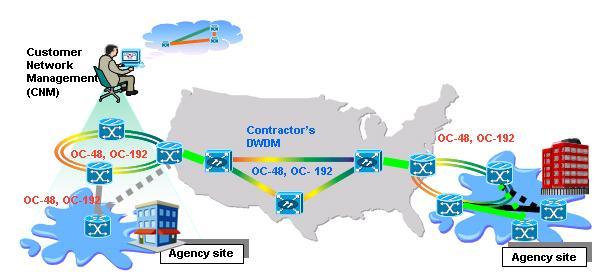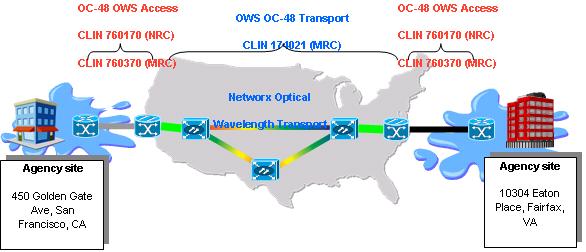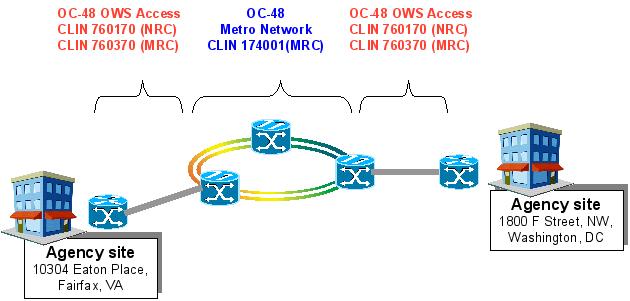OWS provides dedicated high speed optical transport networks to interconnect Agencies offices in different geographic regions. OWS is a new service that was not provided on FTS2001 contracts. Basic OWS is a point-to-point bi-directional, single link service provided by Wavelength Division Multiplexing (WDM) equipment. However, networks with more flexible topologies such as multi-point to multi-point can be provided through emerging technologies.
OWS may be ordered in Metro areas or long haul CONUS wide, with OCONUS and Non-Domestic locations optional to offer. The Agency may opt to manage its own network or to obtain network management from its contractor. OWS is delivered to the customer's Service Delivery Point (SDP). The Agency can order OWS that will connect to and interoperate with:
The diagram below illustrates a CONUS wide contractor's Dense WDM (DWDM) transport network delivering optical carrier (OC) wavelengths. A Customer Network Management (CNM) feature is shown that could include alarm monitoring capabilities as well as capabilities for set up, modification, and tearing-down of connections.

Government Agencies require dedicated broadband, framing-independent transport networks to interconnect their offices in different regions of the United States and internationally. In offering OWS, the contractor always provides the optronics equipment and fiber connectivity that comprise the transport network. Management of the network, however, may be performed by either the providing contractor or the Government Agency. In the latter case, Agencies will manage their dedicated networks via a Web portal or a remote User Interface (UI).
OWS is provided over Wavelength Division Multiplexing (WDM) equipment where several wavelengths, sometimes referred to as lambdas, are multiplexed into a composite signal that is transmitted over a single fiber. An emerging technology known as Automatic Switched Transport Network (ASTN) may be offered as an option by the vendor. ASTN allows traffic paths to be established through the network through an ASTN agent. This agent is also known as an Optical Control Plane. The Optical Control Plane provisions the path through the network as requested by the customer edge-device (e.g., router) and allocates bandwidth for the user requested service, providing more flexibility in meeting user demand. ASTN further enables Agencies to order multi-point to multi-point connections, full mesh configuration, with routing constraints, and Quality of Service (QoS) options. OWS over ASTN also enables network-to-network interconnections to be established.
OWS provides advanced transport capabilities for Government Agencies. OWS allows Agencies to build high speed networks at OC-48 or OC-192 that require physical isolation of traffic to meet bandwidth intensive demands. It supports very fast service set-up/tear-down (i.e., in hours or minutes) and supports low latency and jitter. OWS enables collaborative, dynamic multi-terabit and grid-computing applications and supports fast restoration capabilities (in the sub-millisecond range)
Optional OWS features may be ordered that include:Each Networx contractor may provide variations or alternatives to the offering and pricing for OWS. The specific details can be found within each Contractors Networx contract files and pricing notes for OWS
For more information on the general OWS specifications and requirements, please refer to Section C.2.5.4 of the Networx contract for technical specifications and Section B.2.5.4 for pricing.
OWS is a service that was not offered on the original FTS2001 contracts. OWS is provided over the following two transport technologies:
The Monthly Recurring Charge (MRC) for transport consists of a fixed component plus a distance-dependent (per mile) component. CONUS-to-CONUS distance is calculated using the distance formula:
Distance (miles) = ROUNDUP(SQRT(((V1-V2)^2+(H1-H2)^2)/10),0)
Where (V1, H1) and (V2, H2) are the V and H coordinates of the locations, respectively
Distance involving OCONUS or non-domestic locations is calculated using airline miles. Note: The Networx Pricer automatically calculates the distance when given the originating and terminating locations.
Price components required for full end-to-end service for Domestic and Non-Domestic OWS:Example 1: Domestic OWS WDM Routine Level for OC-48 wavelength

A fixed price is provided for Metro OWS, i.e., transport in a domestic metropolitan area. Thus, the Metro OWS price does not vary by metropolitan area.
Price components required for full end-to-end service for Metro OWS:
Example 2: Metro OWS WDM Routine Level for OC-48 wavelength

Each Networx contractor may provide variations or alternatives to the offering and pricing for OWS. The specific details can be found within each Contractors Networx contract files and pricing notes for OWS.
For more information on the general OWS specifications and requirements, please refer to Section C.2.5.4 of the Networx contract for technical specifications and Section B.2.5.4 for pricing.